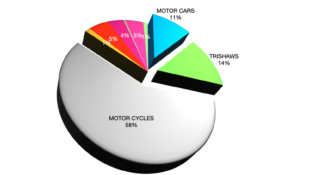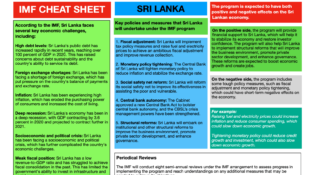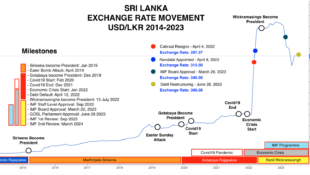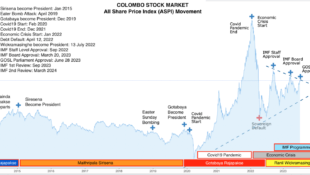By Prof. L.M.K. Tillekeratne
(Former Executive Director RRI and Prof. in Polymer Chemistry, University of Sri Jayawardenepura)
In 2010, the rubber industry recorded a total turnover that exceeds US$600 million and accounted over 6.5% of Sri Lanka's manufacturing exports. This industry employs over 250,000 persons directly and indirectly, which links the traditional tree crop agriculture with industrial manufacturing thereby making these two sectors more stable and competitive in the market place.
In developing nations like China, India and Brazil, per capita consumption of raw rubber shows an increasing trend highlighting an increased global demand for all kinds of Natural Rubber (NR) goods. The size of the world market for rubber products is estimated at $90 billion per annum which is over Rs 116 billion per annum. With planned strategic action Sri Lanka can become an important player in this increasing market. At present rubber products produced in Sri Lanka have a combined market share of only 0.6 to 0.75% of the global market for rubber products. Increasing this to 2 to 2.5% is not overambitious.
Rubber and rubber products exports in Sri Lanka exceeded $1 billion last year; a huge jump compared to the turnover from this sector two years ago. This does not take into account the potential income that could be generated from the export of treated rubber wood products. In some of the other South East Asian rubber producing countries, the income from rubber wood-based products exceeds the income from the rubber products export. Economists assess the benefits to the country from an export product like rubber, only in terms of dollars earned. However, in a small country like ours, an additional major benefit from the rubber industry that is not factored into monetary calculations is its invaluable contribution to the environment.
Prices of all grades of raw rubber in the world market remained well below Rs 100 a kilo for few decades until 2002. Poor prices, which most often were below the cost of production, induced farmers to abandon their rubber plantations without tapping or replanting. As a result, for the first time since 1960s, the total annual rubber production in the country fell below 100,000 Mt (metric tons) to 86,700 Mt in 2000. Thankfully, with price improvement in the world market in 2002, national rubber production also went up and rubber is now the most profitable traditional agricultural crop in Sri Lanka. In this regard, the contribution made by the Rubber Research Institute of Sri Lanka by introducing high yielding clones, inclusive of the world's highest yielding clone RRIC 100, must be remembered with appreciation.
However, the rubber product industry which currently earns over Rs 1 billion per annum, suffered a setback due to a raw rubber shortage in the local market and, starting from 2000, Sri Lanka had to import rubber and latex from neighbouring countries for the domestic rubber products' manufacturing industry. In 2004, the quantum of rubber imported to Sri Lanka rose to over 14,000 Mt but with the rubber newly planted, after the price improvement, coming into bearing, imports have now been curtailed and at present only about 5000 Mt are imported annually. The rubber requirement for the growing rubber products industry in Sri Lanka for 2020 is predicted to be around 180,000 Mt. The question is can we produce this requirement from the existing rubber plantation?
According to the Rubber Development Department, rubber production which is showing a rising trend now, will reach a maximum level and start declining by 2013, until the newly planted areas come into bearing. In such a scenario, where can the Sri Lankan value added rubber products industry turn to for necessary raw material? Although a rubber plantation was launched in the Monaragala district with IFAD funding a couple of years ago, the progress made so far is below expectation, mainly due to bad handling of the project under bureaucratic constraints.
According to Prof. Hidde Smith, Secretary General of the International Rubber Study Group (IRSG), who delivered a lecture titled, "The World Rubber Industry in the Next Decade" in Sao Paulo recently, competition for raw rubber in Asia will be increasing in the forthcoming decade. In 2011, the total rubber production in the world was 10.974 million Mt. According to IRSG predictions, the global rubber production is expected to drop sharply from 2014 onwards due to massive new planting done in the Asian sector during the period 2005 to 2008. However, NR consumption in 2013, 2014 and 2015 is expected to grow steadily at an annual rate of 2.3 to 3.4%, creating more fierce competition for raw material by products' manufacturers.
According to the IRSG predictions, what is most alarming for Sri Lanka is the fact that the major consumers of NR are now in Asia. The three giants - China (33%), India (8.8%) and Japan (7.0%) alone consume almost 50% of the total rubber produced today. Can small timers like Sri Lankan industrialists, who consume only about 80000 Mt of rubber annually, compete with them for NR in the international market?
We should therefore, before it is too late, look at the possibility of establishing plantations in countries like Cambodia and Laos, where Chinese, Malaysian and Indian companies have already invested in very large plantations of over 10,000 Ha blocks. With incentives offered by Cambodia, Laos and Myanmar to export part of the production back to the home country for value addition, Sri Lankan rubber products industry will be able to sustain in the future. In order to address issues connected with the development of the rubber industry in Sri Lanka, the Asian Development Bank initiated the City Cluster Economic Development Project (CCED) to seek ways to foster sustainable economic development. It is a joint approach by the public and the private sectors to address problems and agree on common solutions, a deviation from the traditional single agency bureaucratic and technocratic approach to solve immerging problems.
This approach leads to reduced transaction costs, which benefits both businesses and government communities. The main goal of the CCED is to support the development of the industry cluster for competitive economic development, and the first phase of it has already been launched by establishing a rubber secretariat in Colombo as the centre of the project implementing mechanism. The next phase will be to finalize the draft national business plan for Sri Lanka rubber industry until 2020.
The CCED encourages the government and the private sector to work in partnership and share resources and trade information which benefits the growth and development of the national and regional economies. This approach would be especially useful in encouraging the development of the less developed regions in the country. At present Sri Lanka earns only about 0.6% of the total annual income of the rubber industry of the world. This new concept will help to improve the quality of rubber products manufactured in Sri Lanka, making them more competitive in the global market and enable Sri Lanka to increase its share of the earnings from the rubber industry to Rs 2.5 billion by 2020. It is expected to attract international investors to invest on rubber projects in less developed regions in the country as well.
http://www.sundaytimes.lk/120520/BusinessTimes/bt37.html
 would enable you to enjoy an array of other services such as Member Rankings, User Groups, Own Posts & Profile, Exclusive Research, Live Chat Box etc..
would enable you to enjoy an array of other services such as Member Rankings, User Groups, Own Posts & Profile, Exclusive Research, Live Chat Box etc.. 
 Home
Home
















